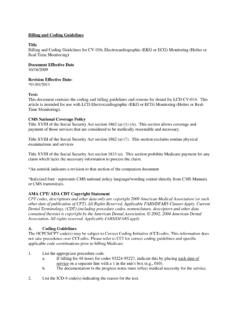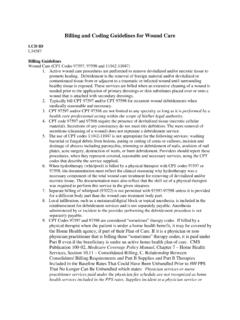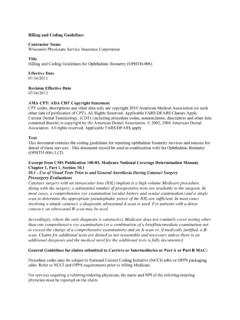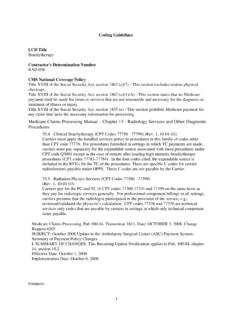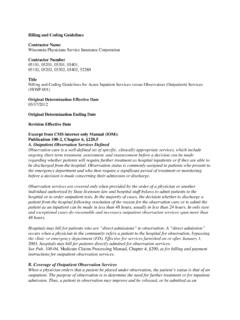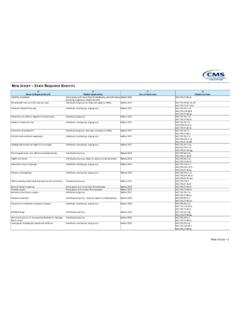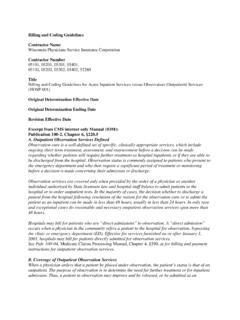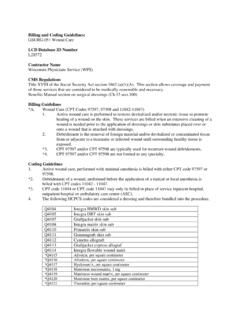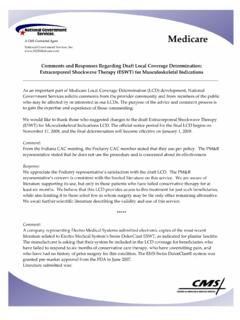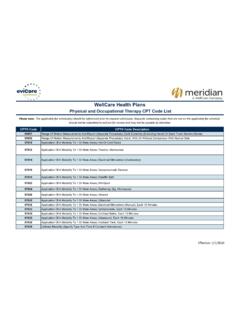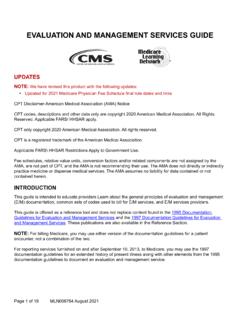Transcription of Billing and Coding Guidelines for Cosmetic and ...
1 Billing and Coding Guidelines for Cosmetic and Reconstructive Surgery LCD The following procedures may be considered reconstructive or Cosmetic . Cosmetic procedures and/or surgery are statutorily excluded by Medicare. These services will be denied as non-covered. Non-covered procedures do not need to be billed to the Contractor. If the beneficiary requests a claim be submitted for a Cosmetic procedure, then use the Billing instructions below to receive a non-covered Cosmetic denial. See WPS LCD L34698 for coverage of the services that are reconstructive and therefore, medically necessary. Cosmetic surgery can be defined as a procedure that is performed to reshape normal structures of the body in order to improve the patient's appearance and self-esteem. These procedures can be performed for medically necessary or Cosmetic reasons. See WPS LCD L34698 for the criteria for medically necessary services.
2 Information below is to assist with Billing for these services when they are performed for Cosmetic reasons. When the following procedures are being performed for Cosmetic reasons use diagnosis code Encounter for Cosmetic surgery and the claim will be denied. 1. Reduction Mammoplasty (CPT 19318) This procedure will be denied when performed for a Cosmetic reason. 2. Mastectomy for gynecomastia (19300): If the tissue removed is primarily fatty tissue, the surgery is classified as Cosmetic and will be denied as non-covered. 3. Rhinoplasty ( cpt codes 30400-30450) When nasal surgery is performed solely to improve the patient's appearance in the absence of any signs and/or symptoms of functional abnormalities, it is considered Cosmetic and will be denied as non-covered. 4. Excision, excessive skin and subcutaneous tissue (including lipectomy); abdomen (abdominoplasty) (15830) is not covered when performed to improve the patient's appearance.
3 5. Chemical Peel (15788-15793) For Cosmetic reasons will be denied as not covered 6. Dermabrasion, segmental, face (15781) performed for a Cosmetic reason will be denied as non-covered. 7. Rhytidectomy (15828, 15829) performed for a Cosmetic reason will be denied as non covered. 8. The following cpt codes /procedures are generally considered Cosmetic and may be medically reviewed or denied as non-covered: 11950-11954 Injection of filling material (collagen) 15780, 15782, 15783 Dermabrasion (eg. acne scarring, fine ) 15819 Cervicoplasty 15824-15826 Rhytidectomy 15832-15839 Excision, excessive skin and subcutaneous tissue, including lipectomy 15876-15879 Suction -assisted lipectomy 17340 Cryotherapy for acne 17360 Chemical exfoliation 17380 Electrolysis 69300 Otoplasty 9. Punch graft hair transplant (CPT 15775-15776) Performed for a Cosmetic reason will be denied as non-covered. 10.
4 Billing for dermal injections for the treatment of Facial Lipodystrophy Syndrome (LDS) that meet the criteria in the NCD: G0429 Dermal Filler injection(s) for the treatment of facial lipodystrophy syndrome (LDS) ( , as a result of highly active antiretroviral therapy) Q2026 Radiesse injection Injection, Radiesse, Q2028 Sculptra injection Injection, Sculptra, Regulation Excerpts: CMS Pub. 100-04 Medicare Claims Processing Manual, Chapter 32 - Billing Requirements for Special Services, Sections: Hospital Billing Instructions (Rev. 2998, Issued: 07-25-14, Effective: Upon implementation of ICD-10; 01-01-12 - ASC X12, Implementation: 08-25-2014 - ASC X12; Upon Implementation of ICD-10) A - Hospital Outpatient Claims For hospital outpatient claims, hospitals must bill covered dermal injections for treatment of facial LDS by having all the required elements on the claim: A line with HCPCS codes Q2026 or Q2028 with a Line Item Date of service (LIDOS) on or after March 23, 2010, A line with HCPCS code G0429 with a LIDOS on or after March 23, 2010, and diagnosis codes B20 (HIV) and (Lipodystrophy).
5 The applicable NCD is Facial Lipodystrophy. B - Outpatient Prospective Payment System (OPPS) Hospitals or Ambulatory Surgical Centers (ASCs): HCPCS code G0429 replaces HCPCS code C9800, Table 2016 OPPS/ASC Final Rule effective January 1, 2017. For line item dates of service on or after March 23, 2010, and until HCPCS codes Q2026 and Q2027 are billable, facial LDS claims shall contain a temporary HCPCS code C9800, instead of HCPCS G0429 and HCPCS Q2026/Q2027, as shown above. C - Hospital Inpatient Claims Hospitals must bill covered dermal injections for treatment of facial LDS by having all of the required elements on the claim: Discharge date on or after March 23, 2010, ICD-10-PCS procedure code 3E00 XGC Introduction of Other Therapeutic Substance into Skin and Mucous Membrances, External Approach, or ICD-10-CM diagnosis codes B20 Human Immundodeficiency Virus [HIV] disease and Lipodystrophy not elsewhere classified.
6 Practitioner Billing Instruction (Rev. 2998, Issued: 07-25-14, Effective: Upon implementation of ICD-10; 01-01-12 - ASC X12, Implementation: 08-25-2014 - ASC X12; Upon Implementation of ICD-10) Practitioners must bill covered claims for dermal injections for treatment of facial LDS by having all the required elements on the claim: Performed in a non-facility setting: A line with HCPCS codes Q2026 or Q2028 with a LIDOS on or after March 23, 2010, A line with HCPCS code G0429 with a LIDOS on or after March 23, 2010, and ICD-10-CM diagnosis codes B20 (HIV) and (Lipodystrophy not elsewhere classified). Performed in a facility setting: A line with HCPCS code G0429 with a LIDOS on or after March 23, 2010, ICD-10-CM diagnosis codes B20 Human Immundodeficiency Virus (HIV) disease and (Lipodystrophy not elsewhere classified). Coding Guidelines 1. Claims do not have to be submitted for Cosmetic procedures.
7 However, if a denial of Medicare coverage is necessary, a GY modifier (items or services statutorily excluded or does not meet the definition of any Medicare benefit) can be used on a Cosmetic procedure to receive a non-covered denial. 2. All submitted non-covered or no payment claims using condition code 21 will be processed to completion, and all services on those claims, since they are submitted as non-covered, will be denied. The default liability for payment of these claims is assigned to the beneficiary, who may then submit the denial from Medicare, as the primary payer, to subsequent payer(s) for consideration. Since a denial is a Medicare determination of payment, all services submitted on no payment claims may be appealed later if unusual circumstances so warrant. That is, all payment determinations are subject to appeal, even denials of services submitted as non-covered. CMS PUB.
8 100-02 Medicare Benefit Policy Manual, Chapter 16 General Exclusions from Coverage, Section 120 - Cosmetic Surgery Cosmetic surgery or expenses incurred in connection with such surgery is not covered. Cosmetic surgery includes any surgical procedure directed at improving appearance, except when required for the prompt ( , as soon as medically feasible) repair of accidental injury or for the improvement of the functioning of a malformed body member. For example, this exclusion does not apply to surgery in connection with treatment of severe burns or repair of the face following a serious automobile accident, or to surgery for therapeutic purposes which coincidentally also serves some Cosmetic purpose. CMS PUB. 100-02 Medicare Benefit Policy Manual Chapter 16 General Exclusions from Coverage, Section 180 - Services Related to and Required as a Result of Services Which Are Not Covered Under Medicare.
9 (Rev. 189, Issued: 06-27-14, Effective: 05-30-14, Implementation: 06-29-14) Medical and hospital services are sometimes required to treat a condition that arises as a result of services that are not covered because they are determined to be not reasonable and necessary or because they are excluded from coverage for other reasons. Services "related to" non-covered services ( , Cosmetic surgery, non-covered organ transplants, non-covered artificial organ implants, etc.), including services related to follow-up care and complications of non-covered services which require treatment during a hospital stay in which the non-covered service was performed, are not covered services under Medicare. Services "not related to" non-covered services are covered under Medicare. Following are examples of services "related to" and "not related to" non-covered services while the beneficiary is an inpatient: A beneficiary was hospitalized for a non-covered service and broke a leg while in the hospital.
10 Services related to care of the broken leg during this stay is a clear example of "not related to" services and are covered under Medicare. A beneficiary was admitted to the hospital for covered services, but during the course of hospitalization became a candidate for a non-covered transplant or implant and actually received the transplant or implant during that hospital stay. When the original admission was entirely unrelated to the diagnosis that led to a recommendation for a non-covered transplant or implant, the services related to the admitting condition would be covered. A beneficiary was admitted to the hospital for covered services related to a condition which ultimately led to identification of a need for transplant and receipt of a transplant during the same hospital stay. If, on the basis of the nature of the services and a comparison of the date they are received with the date on which the beneficiary is identified as a transplant candidate, the services could reasonably be attributed to preparation for the non-covered transplant, the services would be "related to" non-covered services and would also be non-covered.
